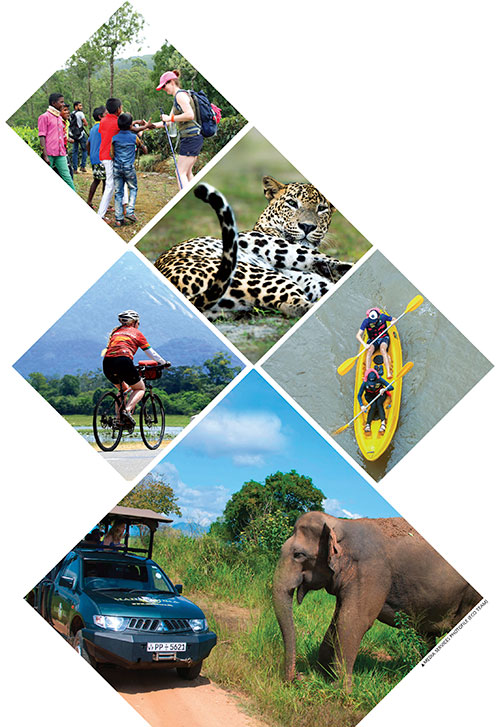THE HIGH-OCTANE SHIFT
Anuruddha Bandara delves into Sri Lanka’s growing status as an adventure hub

Sri Lanka’s tourism identity is undergoing a powerful transformation and emerging as a premier destination for adventure tourism. With its compact geography and ecological richness, the island offers a range of experience, from high-octane thrills to nature immersed journeys.
“Adventure in Sri Lanka is incredibly diverse,” says Anuruddha Bandara.
He elaborates: “It’s shaped by the traveller’s preferences, personality and cultural background. For some, an unforgettable adventure might mean tasting street food in Pettah while for others, it could be paddling down a river trail from Ratnapura to Kalutara or spending the night in a jungle lodge.”
Bandara points out that the infrastructure supporting adventure tourism is improving with activities such as hot air ballooning, paramotoring and parachuting becoming more accessible and better regulated. This momentum is positioning Sri Lanka as a rising star and global adventure tourism destination.
According to him, some of the country’s most thrilling experiences include treks in areas such as the Knuckles Mountain Range and Horton Plains.
“We’ve developed a seven day trail that starts in Bogawantalawa and ends in Kaltota. It showcases Sri Lanka’s ecological transitions and provides an experience that’s both physically challenging and spiritually rewarding,” he explains.
Cycling has also become a cornerstone of the adventure experience. Bandara notes that the 21 day Paddle Sri Lanka cycling route offers cyclists the ultimate challenge: “It combines adventure with cultural discovery, taking riders through remote villages, tea estates, coastal roads and forested paths.”
Bandara notes that diving enthusiasts are drawn to the country’s shipwreck sites – such as the Great Basses Reef and Taprobane East Wreck off Colombo – which offer a blend of marine life and maritime history.
Canoeing down rivers provides a quieter yet equally immersive adventure and takes travellers through pristine natural landscapes. Meanwhile, surfing hotspots such as Arugam Bay and Kalpitiya continue to attract thrill seekers from around the globe.

Bandara also reflects on the evolving nature of adventure tourism: “Today’s travellers are looking for something deeper – there’s a desire for purpose driven travel where people can connect with local communities, contribute to sustainability and return home with more than just photographs.”
Sri Lanka is actively aligning itself with these global trends. According to Bandara, initiatives such as the National Sustainable Tourism Certification Scheme (NSTCS) are promoting environmentally responsible tourism practices.
In parallel, community based tourism projects are gaining traction, ensuring that local communities benefit while also enhancing the authenticity of the visitor experience.
“There’s also a growing interest in combining wellness with adventure,” he adds, going on to explain that “people want to come here to trek or cycle but also to slow down, meditate and take part in cultural rituals. We’ve seen this with our annual Paddle Sri Lanka cycling challenge, which – while being about endurance – also involves connecting with the land and its people.”
When comparing Sri Lanka to other destinations such as Nepal and Thailand, Bandara highlights the island’s size and ecological diversity as key advantages. “In a few hours, you can travel from beaches to mountains, or ancient ruins to rainforests,” he points out.
As he says, “Nepal is amazing for high altitude trekking and Thailand excels in beach tourism but Sri Lanka offers it all within a short radius.”
He also highlights the country’s cultural depth and biodiversity as distinguishing features. With ancient temples, colonial architecture, vibrant festivals, and biodiverse national parks such as Wilpattu and Sinharaja, Sri Lanka delivers an immersive experience that complements its adventure offerings.
“And, of course, there’s the legendary Sri Lankan hospitality. That’s something you simply can’t replicate,” Bandara adds.
He is cautiously optimistic about investment too. Last year, Sri Lanka garnered around US$ 72 million in tourism related investments with over 40 proposals to add new hotel rooms.
However, Bandara stresses that investment needs to go beyond infrastructure: “We need more focus on training and certification, for adventure guides and instructors. Currently, much of this responsibility falls on the private sector. With stronger government support, we could build a more robust foundation.”
And he emphasises the importance of public-private partnerships (PPPs), noting that while policy reforms and infrastructure projects are moving in the right direction, the industry’s true potential will only be realised through greater collaboration.
“We’ve come a long way,” he says, “but we have so much further to go.”
Finally, Bandara touches on the national policy landscape. Sri Lanka is in the process of finalising a National Tourism Policy that emphasises sustainability, cultural preservation and inclusivity. While this framework is promising, Bandara believes more targeted action is required to unlock the full potential of adventure tourism.
“We need to improve access to remote adventure sites, train local communities in global best practices and launch strategic marketing campaigns that position Sri Lanka as a world-class destination,” he says.
And Bandara concludes: “If we invest in these areas smartly and consistently, there’s no reason why Sri Lanka can’t lead the region in adventure tourism.”
